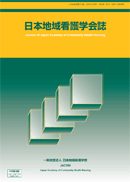Volume 15, Issue 2
Displaying 1-12 of 12 articles from this issue
- |<
- <
- 1
- >
- >|
-
Article type: Article
2012Volume 15Issue 2 Pages 7-17
Published: December 31, 2012
Released on J-STAGE: April 20, 2017
Download PDF (1268K) -
Article type: Article
2012Volume 15Issue 2 Pages 18-26
Published: December 31, 2012
Released on J-STAGE: April 20, 2017
Download PDF (966K) -
Article type: Article
2012Volume 15Issue 2 Pages 27-37
Published: December 31, 2012
Released on J-STAGE: April 20, 2017
Download PDF (1395K) -
Article type: Article
2012Volume 15Issue 2 Pages 38-45
Published: December 31, 2012
Released on J-STAGE: April 20, 2017
Download PDF (1010K) -
Article type: Article
2012Volume 15Issue 2 Pages 46-54
Published: December 31, 2012
Released on J-STAGE: April 20, 2017
Download PDF (1169K) -
Article type: Article
2012Volume 15Issue 2 Pages 55-63
Published: December 31, 2012
Released on J-STAGE: April 20, 2017
Download PDF (1085K) -
Article type: Article
2012Volume 15Issue 2 Pages 64-72
Published: December 31, 2012
Released on J-STAGE: April 20, 2017
Download PDF (979K) -
Article type: Article
2012Volume 15Issue 2 Pages 73-80
Published: December 31, 2012
Released on J-STAGE: April 20, 2017
Download PDF (908K) -
Article type: Article
2012Volume 15Issue 2 Pages 81-88
Published: December 31, 2012
Released on J-STAGE: April 20, 2017
Download PDF (880K) -
Article type: Article
2012Volume 15Issue 2 Pages 89-96
Published: December 31, 2012
Released on J-STAGE: April 20, 2017
Download PDF (995K) -
Article type: Article
2012Volume 15Issue 2 Pages 97-106
Published: December 31, 2012
Released on J-STAGE: April 20, 2017
Download PDF (1224K) -
Article type: Article
2012Volume 15Issue 2 Pages 107-113
Published: December 31, 2012
Released on J-STAGE: April 20, 2017
Download PDF (809K)
- |<
- <
- 1
- >
- >|
